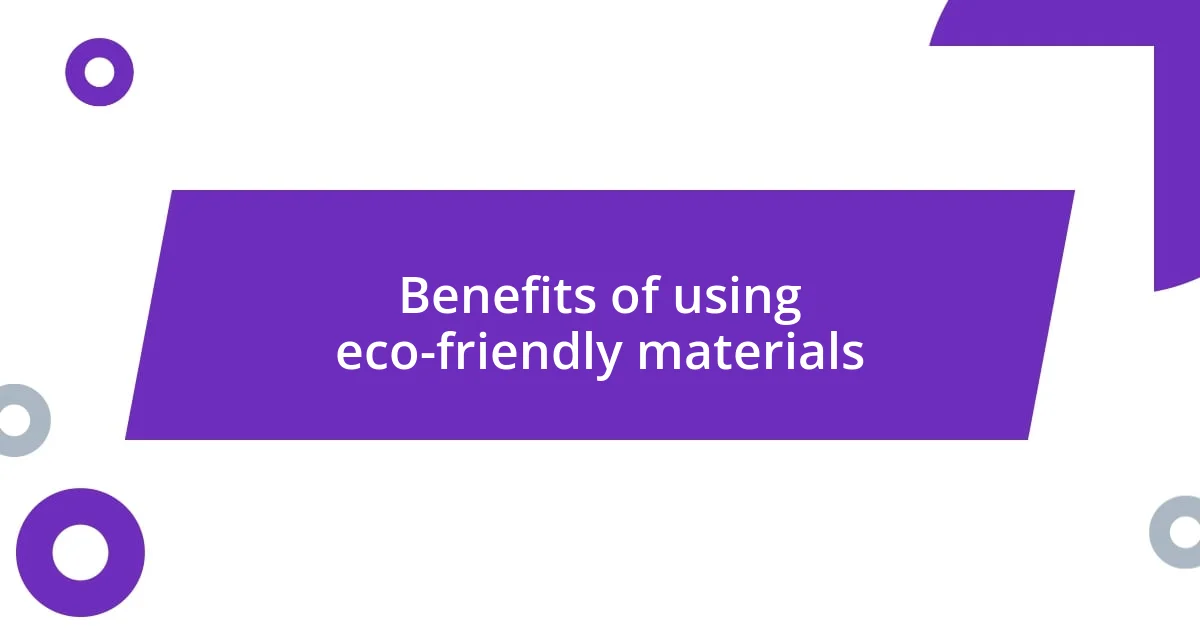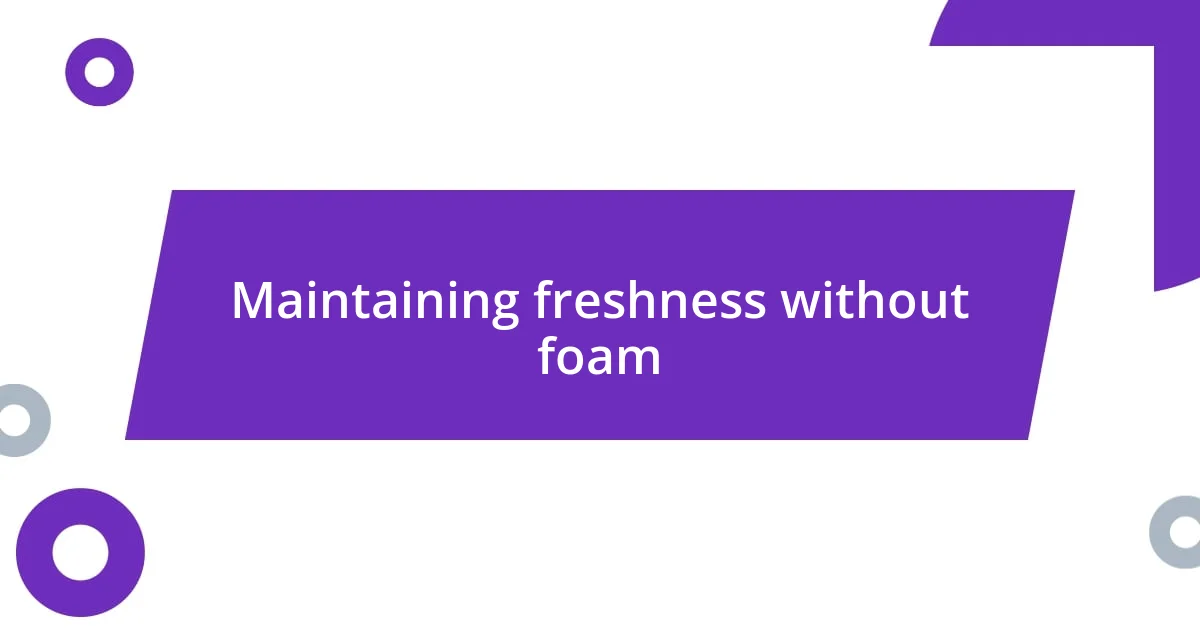Key takeaways:
- Exploring alternatives to floral foam, such as chicken wire and natural sponges, promotes creativity and sustainability in floral design.
- Using eco-friendly materials reduces environmental impact, supports biodiversity, and enhances the aesthetic appeal of floral arrangements.
- Maintaining flower freshness without foam can be achieved through methods like using water-saturated materials, adding sugar to vase water, and regular water maintenance.

Understanding floral foam alternatives
When I first started exploring floral foam alternatives, I was amazed at how many options were available. It’s not just about finding something that holds flowers; it’s about embracing materials that can be more sustainable and environmentally friendly. Have you ever considered what your floral arrangements might contribute to the planet? I know I did, and it led me down a fascinating path.
One intriguing alternative I discovered is using chicken wire, which surprisingly offers a sturdy base for arranging flowers. I remember the first time I tried it; I was a bit skeptical, but as I worked with it, I realized it gave me so much freedom to create! The flexibility of this material allowed my creativity to flourish, unlike any rigid foam could. Doesn’t it feel liberating to use something that truly supports the beauty of the blooms without compromising on environmental values?
Another option that caught my attention is the use of biodegradable materials, such as moss or even recycled paper. I often reflect on the feeling of nurturing flowers in an eco-conscious way. It’s like giving the blooms a second chance at life while ensuring our planet is cared for too. When you think about the impact your choices can have, doesn’t it inspire a different approach to floristry? Just imagine the satisfaction of knowing your beautiful arrangements help the Earth thrive in return!

Benefits of using eco-friendly materials
Using eco-friendly materials in floral arrangements has been a game-changer for me, both creatively and emotionally. There’s something inherently fulfilling about choosing products that nurture the planet while adding beauty to our lives. Every time I reach for sustainable substitutes, I feel like I’m making a small yet impactful contribution to the environment, which enhances my connection to the floral craft.
Here are some benefits of using eco-friendly materials:
- Reduced Environmental Impact: By opting for biodegradable or recyclable options, we help decrease landfill waste and pollution.
- Promotes Biodiversity: Utilizing natural materials encourages the growth of plant life, supporting ecosystems.
- Enhanced Aesthetic Appeal: Natural substances often have textures and colors that provide a unique charm to arrangements.
- Educates Others: When people see your environmentally friendly designs, it sparks conversation and awareness about sustainability in floristry.
- Inner Satisfaction: The emotional reward of creating with conscious materials can transform the way we approach art and design.
Switching to eco-friendly options has significantly changed my perspective on floristry. It’s like I’ve donned a new lens through which I can appreciate not only my work but also the broader implications of my choices. Each arrangement I create now feels like a statement — I’m not just celebrating beauty, but also cherishing our planet.

Types of floral foam alternatives
When it comes to floral foam alternatives, one that stands out for me is floral wire. Not only is it versatile, but it also adds an artistic element to my arrangements. I recall using it for a wedding bouquet; the delicate loops of wire helped me create a cascading effect that was both breathtaking and functional. The best part? Knowing I avoided harmful products made the experience even sweeter.
Another fascinating alternative I’ve encountered is using natural sponges. It may sound unconventional, but sponges provide fantastic moisture retention for fresh flowers. When I first tried this method, I was pleasantly surprised by how well the flowers held up over time. Plus, there’s something incredibly satisfying about incorporating a natural element from the ocean into my work. Who knew floral arranging could take us on such unexpected journeys?
Lastly, I often turn to soil or potting mix for potted arrangements. This choice reinforces the connection between flowers and their natural habitat. It instantly gives me that warm, grounded feeling, as if I’m nurturing something that thrives in its environment. I vividly remember creating a centerpiece with herbs mixed into the soil; not only did it look gorgeous, but the aroma filled the air with earthy freshness. This blend of beauty and practicality always sparks joy in my floral design process.
| Type of Alternative | Description |
|---|---|
| Floral Wire | Versatile and adds artistic elements to arrangements. |
| Natural Sponges | Excellent moisture retention, creates unique textures. |
| Soil/Potting Mix | Enhances connection to natural habitats and provides nourishment. |

Practical tips for using alternatives
When I’m using alternatives like floral wire, one tip that really helps is to experiment with different techniques to secure the flowers. For instance, instead of merely wrapping wire around stems, I often create interesting spirals that not only hold flowers in place but also add a dynamic visual element. Have you ever noticed how a simple twist can transform the entire look of a bouquet? It’s all about playing with textures and shapes to elevate your arrangements.
Natural sponges have been a delightful discovery for me, especially when I’m feeling adventurous in my designs. I learned that soaking the sponge before inserting my flowers greatly enhances moisture retention. The first time I employed this method, I was amazed at how vibrant my arrangements looked days later! It’s thrilling to think about the beauty of the ocean enhancing my work, right? Don’t be afraid to try out various sponges until you find the one that truly suits your style.
One practical tip I love is incorporating soil or potting mix in potted arrangements. Not only does it provide flowers with the nutrients they need, but it also creates a more authentic feel. I remember a time I mixed different types of potting soil to achieve a rustic effect in a display. The varied textures not only captivated my audience but also sparked conversations about gardening and sustainability. How often do we get to tie back our floral designs to nature itself? It’s moments like these that keep my passion for floristry alive.

Creative arrangements with alternatives
When I first experimented with using twigs and branches as a framework for my floral arrangements, I was amazed at the unique structure it created. The organic lines added a rustic charm that brought the whole design to life. I often think about how these natural elements connect us back to the earth, don’t you? Each piece tells a story, and I love sharing that story with others.
Using fruit as part of my arrangements was another delightful leap into creativity. I recall a stunning display where I nestled lemons and oranges among the blooms. The bright colors and fresh scents were so inviting that guests couldn’t resist reaching out to touch. Have you ever considered how incorporating edible elements not only enhances aesthetics but also creates a multisensory experience? It’s a wonderful way to surprise and engage everyone.
I’ve also found joy in repurposing everyday objects, like coffee mugs or tin cans, as vessels for floral designs. Those quirky containers can really add a personal touch to a bouquet. I once created a cheerful arrangement using an old tin I had saved from my grandmother’s kitchen, and it sparked so many memories. How can we help but feel nostalgic when we bring cherished items into our floral work? It’s this blend of creativity, sustainability, and personal history that truly resonates with me.

Maintaining freshness without foam
Maintaining freshness in floral arrangements without foam can be surprisingly simple. I’ve discovered that placing flowers in water-saturated materials, like chicken wire, allows for excellent hydration while enabling creativity in shape and design. The first time I used this technique, I was delighted by how easily I could manipulate the stems to create an airy, flowing look. Have you ever felt like a sculptor when arranging flowers? It’s a liberating experience.
Additionally, I often use a clean vase filled with fresh water and a bit of sugar to nourish my blooms. It might sound old-fashioned, but this natural method enhances not only longevity but also the vibrancy of the flowers. Once, when a friend gifted me a bouquet, I added sugar to the water, and the difference was incredible—the colors popped, and the arrangement seemed to dance in the light. Isn’t it amazing how a simple ingredient from the pantry can create such magic?
I find that keeping the water level topped up regularly plays a significant role in the arrangement’s lifespan. I remember the first time I got busy and lost track of time while working on a project. When I finally remembered to check the water, I was met with droopy blooms—such a letdown! Since then, I’ve set reminders on my phone. Have you ever experienced that mix of excitement and disappointment in your arrangements? Keeping flowers hydrated is key to ensuring they remain stunning and fresh, reflecting the care we put into our work.














